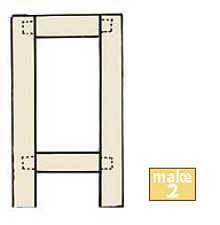Build an Advanced Jeweler’s Bench
This sophisticated bench costs a little more and is a bit more difficult to make than the one on the preceding page, but the extra effort will be repaid by years of efficient work. Use this pattern as a starting point, but feel free to make changes to suit your individual needs.
2 Minute Read
This sophisticated bench costs a little more and is a bit more difficult to make than the one on the preceding page, but the extra effort will be repaid by years of efficient work. Use this pattern as a starting point, but feel free to make changes to suit your individual needs.
This bench is made of maple or a similar hardwood. Construction requires a table saw and cabinetmaking skills. The sizes given are standard, but of course you can change them to suit your needs. An advantage of this bench is that it breaks down to travel and can be fit in the trunk of a car.
Parts List
All measurements refer to inches.
- Top (1) 36 x 22 x 1 1/2
- Legs (4) 36 x 3 x 1 1/2
- Short Braces (4) 20 x 3 x 1 1/2
- Long Braces (2) 36 x 3 x 1 1/2
Drawer
- Sides (2) 20 x 6 x 3/4
- Front (1) 34* x 6 x 3/4 [*] approximate
- Back (1) 32 x 6 x 3/4
Sweeps
- Sides (2) 20 x 3 x 3/4
- Front (1) 34* x 2 x 3/4 [*] approximate
- Back (1) 32 x 3 x 3/4
See also: Build a Basic Jewelers Bench
Our guide to the best jewelers workbenches you can buy
You assume all responsibility and risk for the use of the safety resources available on or through this web page. The International Gem Society LLC does not assume any liability for the materials, information and opinions provided on, or available through, this web page. No advice or information provided by this website shall create any warranty. Reliance on such advice, information or the content of this web page is solely at your own risk, including without limitation any safety guidelines, resources or precautions, or any other information related to safety that may be available on or through this web page. The International Gem Society LLC disclaims any liability for injury, death or damages resulting from the use thereof.
The All-In-One Jewelry Making Solution At Your Fingertips
When you join the Ganoksin community, you get the tools you need to take your work to the next level.
Trusted Jewelry Making Information & Techniques
Sign up to receive the latest articles, techniques, and inspirations with our free newsletter.




